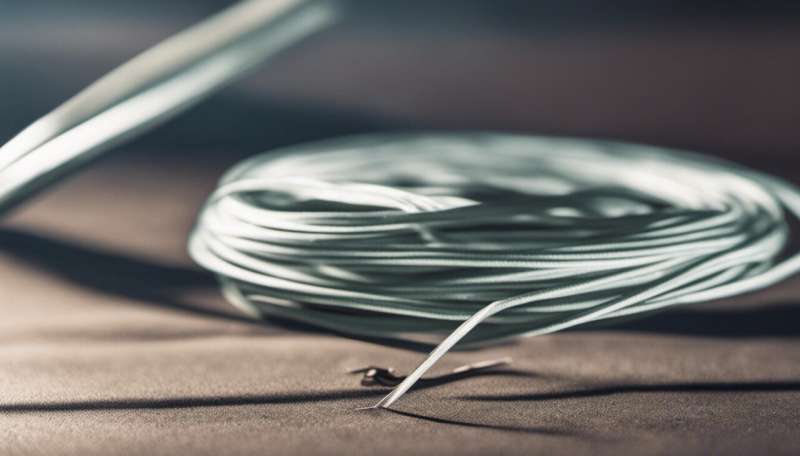This article has been reviewed according to Science X's editorial process and policies. Editors have highlighted the following attributes while ensuring the content's credibility:
fact-checked
trusted source
proofread
You could be flossing all wrong, if you're even flossing at all

Flossing is the healthy habit most of us love to hate. In survey after survey, Americans report dismal rates for consistent daily flossing—and they also admit lying to their dentists about it. But dentists already know that just from looking at their patients' mouths.
Dentists also know from experience that flossing and other means of removing toxic dental plaque from the tooth surface underneath the gumline can help prevent long-term dental disease. A recent study from researchers at Tufts University School of Dental Medicine (TUSDM) backs this up, finding that people who learned and consistently used proper flossing technique showed fewer indicators of potential severe disease than those who did not.
"Flossing is beyond just putting a piece of floss between your teeth to get a piece of food out," says periodontist David Basali, DG19, MSD19, the study's lead author, who conducted the work while a resident in the TUSDM periodontology program.
Here's the technique dentists recommend
- Wrap each end of a 15- to 18-inch length of floss around the ring or middle finger of both hands; the floss remaining between the fingers should be about 5 to 6 inches long.
- Hold the useable floss with the index finger and/or thumb of each hand. Use only 3/4" of floss between fingers of each hand. These fingers will control the floss and should keep it from cutting into the gums.
- Start at one end of either the top or bottom set of teeth and apply the floss to the curved surface of the tooth, like bending a "C" around the tooth.
- Move the floss in a short forward-backward motion, as well as upwards and downwards, as if drying your back with a towel.
- Continue to the next tooth, using the floss to clean both edges of the teeth.
The study, which was published in August in the Journal of Dental Hygiene, was prompted by an attention-grabbing 2016 article from the Associated Press that focused on the scarcity of evidence supporting the long-term efficacy of flossing. Dental professionals responded by pointing out that since severe periodontal disease takes years to develop, it would be almost impossible—and unethical—to conduct a decades-long controlled study.
"In the aftermath of the 2016 AP coverage, studies were done showing that most people really aren't flossing accurately," Basali says. And previous flossing studies did not take technique into account. With folks dragging the floss through their mouth any which way, no wonder today's researchers thought the data was undependable.
To untangle the flossing question, the Tufts group looked at a marker of potential disease: bleeding gums. The researchers examined 36 people with gingivitis, the earliest stage of gum disease. About half of all adults in the U.S. have some degree of gingivitis; a symptom is gums that bleed when probed or during brushing. Half of the patients were trained to floss using what is known as the "adapted horizontal vertical flossing technique," or AHVFT, and asked to document their daily flossing. The others were left to their usual flossing styles and routines.
After eight weeks, the group that received instruction in flossing technique and stuck to a daily regimen had a 70% reduction in bleeding gums, compared to 30% for the control group.
"This is the first study of which we are aware to prove that a person using floss with a specific technique will have less gum infection than a person who just does what they normally do," says Paul Levi, D66, DG71, a co-author of the study who has taught periodontology at TUSDM for 20 years.
A quick primer on what goes on in your mouth: Bacteria that live there metabolize nutrients in the saliva and the fluid in the gum crevice. The bacteria secrete sticky and toxic waste products that are called dental plaque and biofilm, which in turn can lead to decay and gum inflammation. This creates, among other ailments, periodontal diseases, which affect both the gums and bone, threaten the stability of the teeth, and can interfere with general health throughout the body.
Proper flossing should remove the plaque and biofilm—the stuff you can't see—and not just that unsightly piece of spinach or annoying sesame seed. "The food is just a piece of food," Basali says. "It's the bacteria building up around the teeth that will cause the inflammation, the cavities, and the dental disease."
The AHVFT flossing technique used by the researchers is similar to the technique promoted by the American Dental Association. Good flossing style will also help avoid unintentional damage to the gums.
"Sometimes we see patients traumatize the gum line with improper flossing technique, which can create clefts by cutting the gum and can lead to gum recession," says Irina F. Dragan, DG15, MSD15, DI19, a co-author of the paper and faculty member at TUSDM. "The AHVFT assures that the floss is well-adapted to the side of the tooth to prevent floss cuts."
It did not take long for the study subjects to get the hang of it; by the end of the eight-week study, 88% of those who had received flossing instruction had mastered the skill.
More information: The Effect of Dental Flossing Instructions and Technique on Interproximal Bleeding: A randomized control trial. Journal of Dental Hygiene, jdh.adha.org/content/97/4/36


















